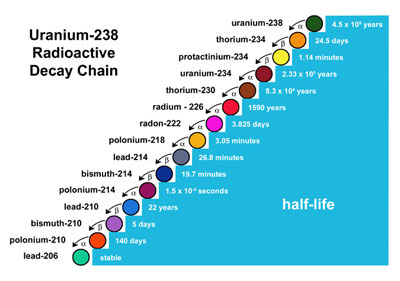
Uranium — What is It?
Uranium (U) is a metallic, silver-gray element that is a member of the actinide series. It is the principle fuel for nuclear reactors, but it also used in the manufacture of nuclear weapons.

Uranium has an atomic number of 92 which means there are 92 protons and 92 electrons in the atomic structure. U-238 has 146 neutrons in the nucleus, but the number of neutrons can vary from 141 to 146. Because uranium is radioactive, it is constantly emitting particles and changing into other elements. Uranium has a well-established radioactive decay series. U-238 and U-235 (which has 143 neutrons) are the most common isotopes of uranium. Uranium naturally contains all three isotopes (U-238, U-235 and U-234), and it rarely varies more than 0.01% from the average composition shown in the table below without our intervention.
| Isotope | % found in natural U | % found in Enriched U* | % found in Depleted U |
|---|---|---|---|
| U-238 | 99.28% | 96.471% | 99.8% |
| U-235 | 0.72% | 3.5% | 0.2% |
| U-234 | 0.0057% | 0.029% | 0.001% |
| * Reactor-grade enriched uranium (normally varies from 3.5 to 5% U-235) | |||

Source: Wikimedia Commons
To produce fuel-grade uranium, the uranium has to be processed to produce uranium dioxide and to enrich or concentrate the U-235 in the fuel pellets. During this processing, depleted uranium (DU), enriched in U-238 and depleted in U-235, is produced. DU and enriched uranium have numerous civilian and military uses. Since U-235 is the most radioactive isotope of uranium, the removal of it to makes DU the least radioactive phase of uranium, but it still has heavy metal toxicity issues.
Despite any processing, enriched, depleted or natural uranium all behave the same chemically. Uranium ore oxidizes to uranium oxy-hydroxides when exposed to the air and/or water.
U-235, when bombarded by neutrons, fissions or splits into two smaller nuclei and releases energy and starts a nuclear chain reaction. Because of the energy released, U-235 is efficient for power generation and the only isotope of uranium that can sustain these reactions. For electrical power plants, this reaction is controlled so that it will not produce too many neutrons or heat and become explosive. Go to The Basics of Nuclear Reactions to find out more about nuclear reactions.
Because uranium decays by emitting alpha particles at a constant rate (half-life = time it takes for half of the material to decay to another substance), uranium minerals are very useful for dating rocks and determining the age of the earth.
| Isotope | Time |
|---|---|
| U-238 | 4.468 billion years |
| U-235 | 703.8 million years |
| U-234 | 245,500 years |
Uses for Uranium
Besides nuclear power plant fuel, U has numerous other military and civilian uses. Uranium and other radionuclides are used by nuclear medicine (MRIs, X-rays, radioisotope injections, radiation treatment, etc.), scientific research (age-dating materials, compositional information, metabolic studies, etc.), agriculture (irradiating food and seeds), consumer products (smoke detectors, watches, irradiating bandages and other items to sterilize them, computer components, etc), materials testing for numerous industries (automotive, aircraft, construction, mining and oil) and space exploration (fuels). In addition, depleted uranium (DU) has been used for counterweights in sail boat's keel, ballast in boats, pigments and radiation shielding.
Depleted uranium is used by the military for its armour piercing capabilities as penetrators, and highly enriched (>90% U-235) Uranium is used by the military for weapons.
Links to more information
Any mention or link regarding a product, organization, company, or trade name is for information only and does not imply endorsement by the Bureau, NMT, or the State of New Mexico (see more).
- Uranium Minerals
- LANL Periodic Table - Uranium
- Wikipedi - Uranium
- IEER Fact Sheet
- ATSDR Fact Sheet
- WISE Uranium Project
- NEI - How it works
- How Stuff Works - Dating Rocks
- Infoplease
For Kids & Teachers:
- DOE - Ionizing Radiation
- Its Elemental! - Uranium
- World Nuclear Association
- NIEHS Kids' Pages


